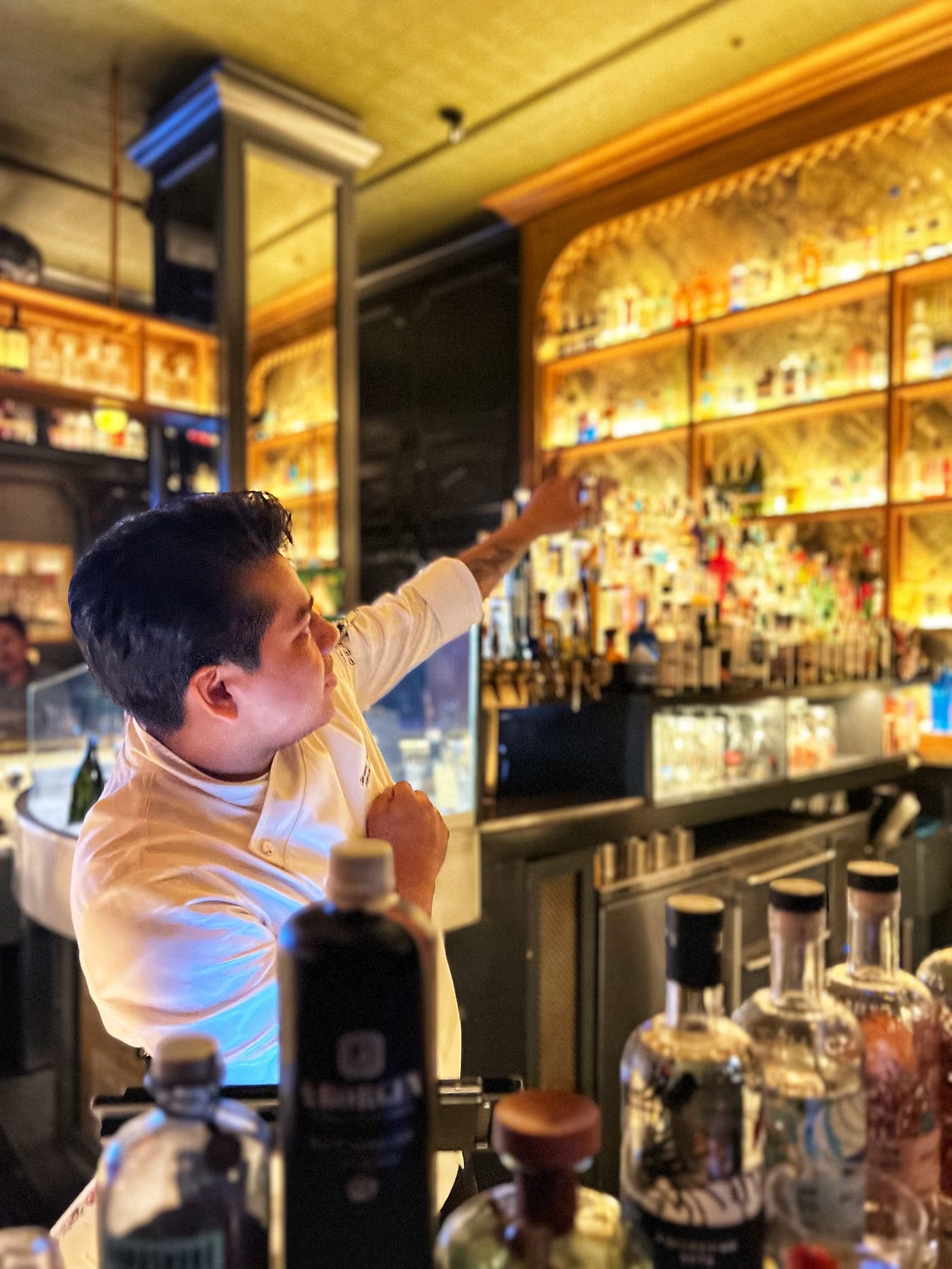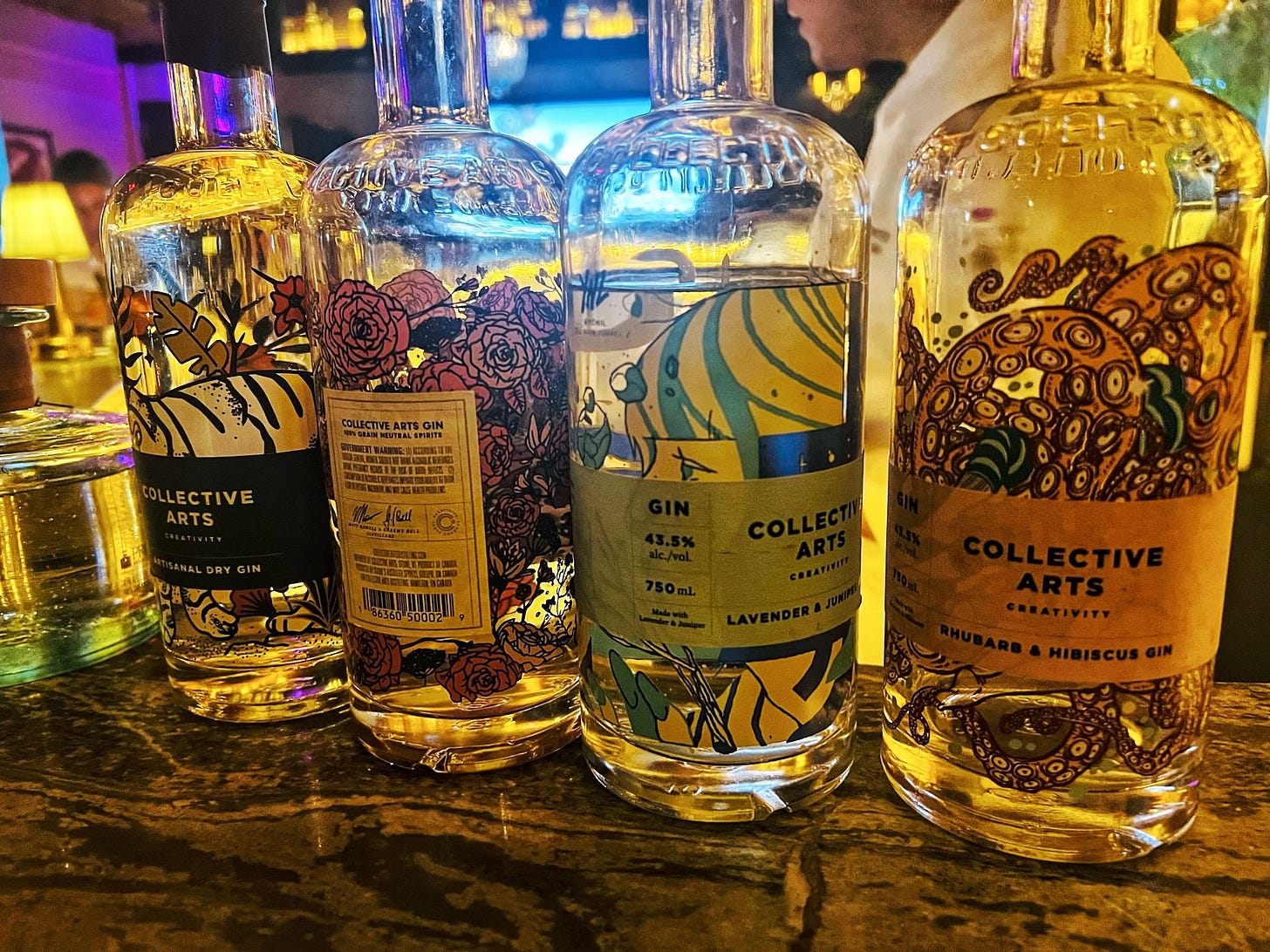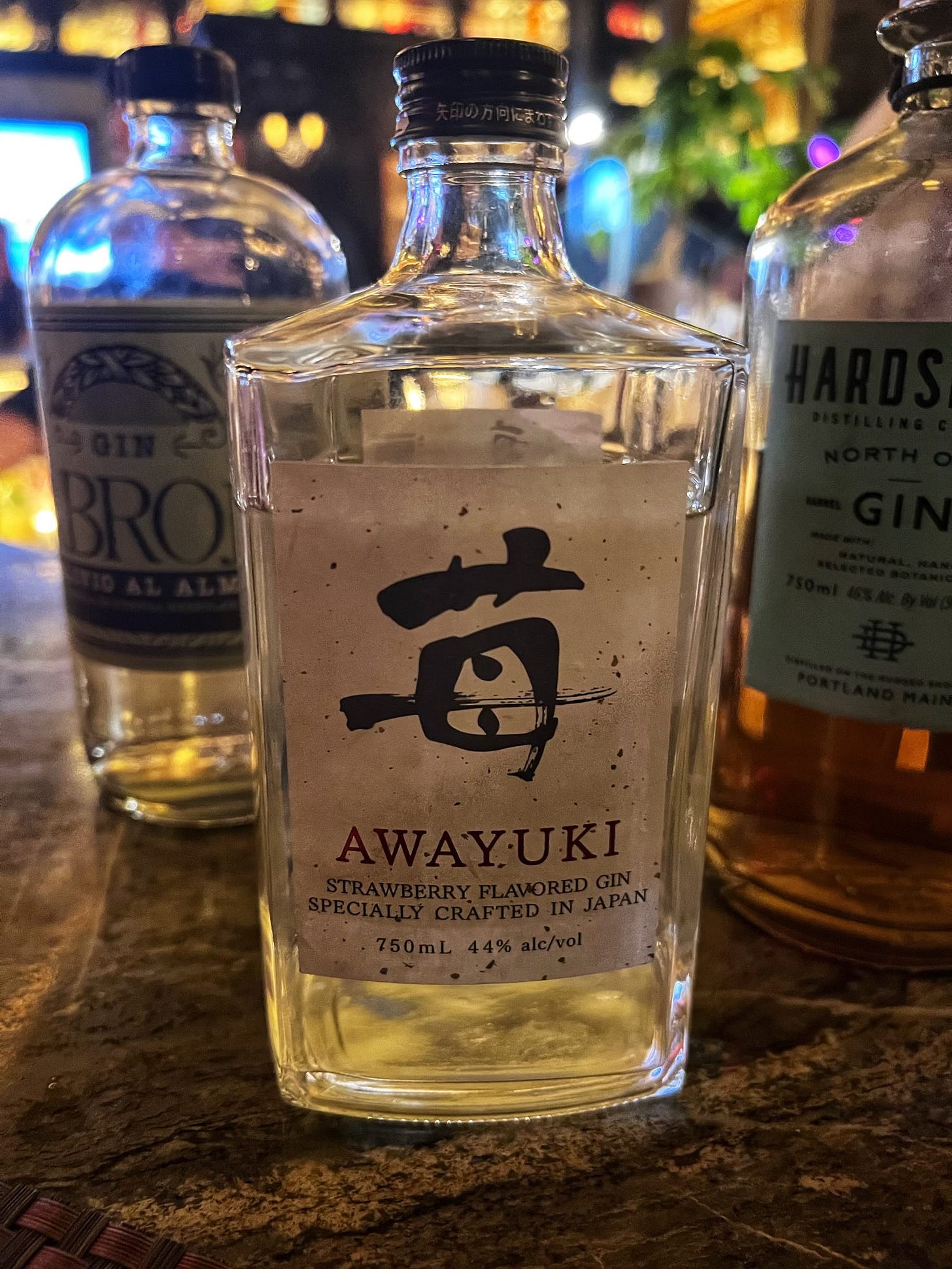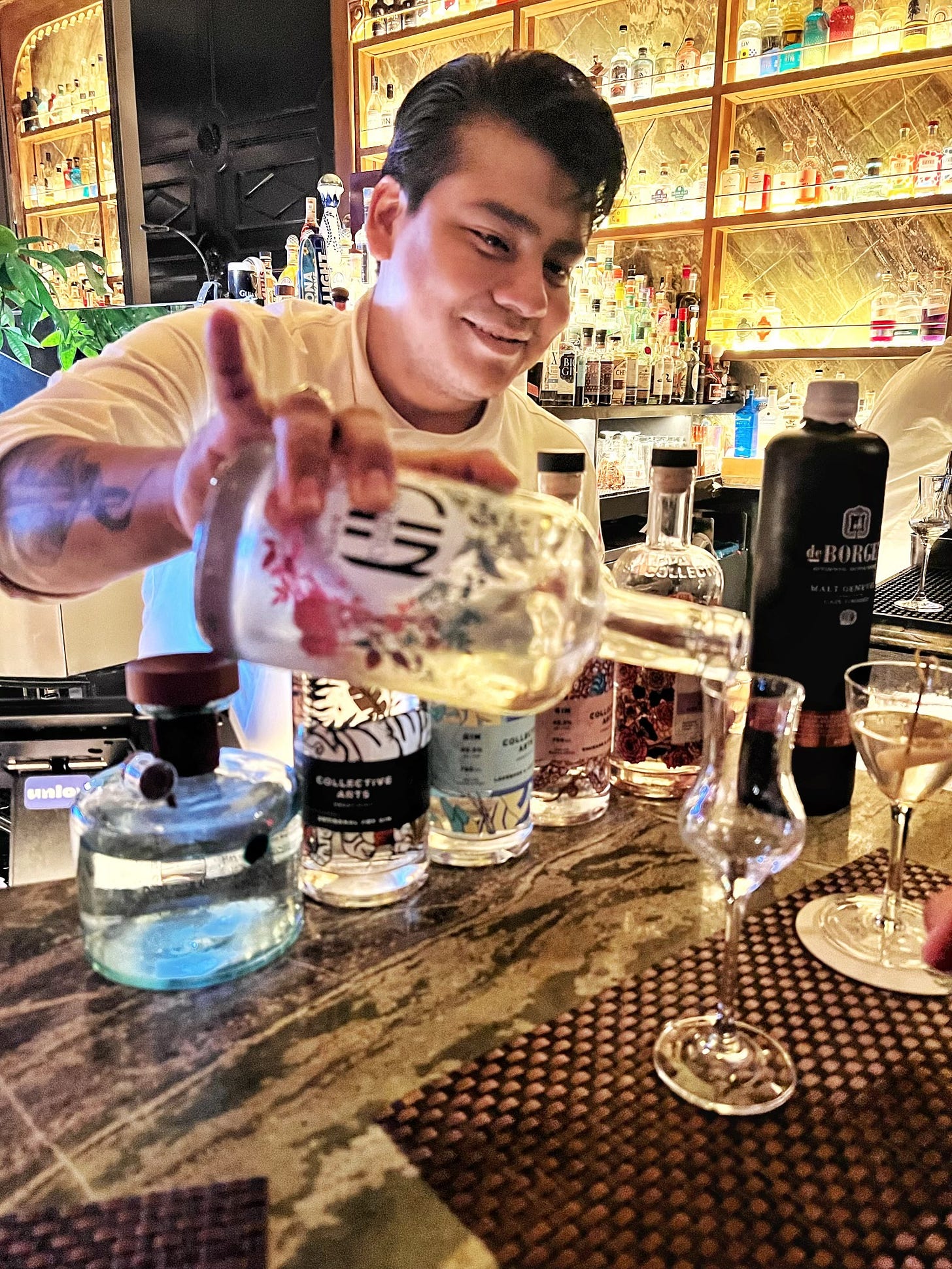The Land of 1,000 Gins
A Visit to Ivory Peacock, Manhattan’s Gin Palace. Plus, reviews of Old Tom and Barrel-Aged gins.
Welcome to Day 4 of “Gin Week” at The Mix. Today, we get out in the field and pay a call on the preeminent gin bar in New York City, Ivory Peacock, which opened on W. 26th Street in the Nomad district in Manhattan about 18 months ago.
It seemed to best place to try some unusual and unfamiliar gins. We arrived at 5 p.m. on a recently weekday and took a seat at the horseshoe bar in the back of the expansive bar (the best and most popular seats in the house, we were informed).
But before we dive into that adventure, an offer!
Here at The Mix, we are grateful to have a large group of subscribers—and quite a few new free subscribers who have all joined within the last few weeks.
We appreciate all of you and hope that this week you really enjoy the Gin articles, interviews, recipes and round-ups we have in store.
During Gin week, if you decide to become an annual member, we are offering 20% OFF if you click on the link below. The secret password is GIN.
Thanks from The Mix!
“So, how many gins have you got here,” I asked the bartender Daniel Benitez. He was wearing a white smock that had the words “Head of Gin” embroidered on it, near where a pocket would be.
I knew it had to be a lot. Hundreds. I was sitting at the horseshoe bar at the back of Ivory Peacock and looking right at a bunch of them. They lined the back-lit shelves at the rear of the bar that went all the way to the ceiling, which was probably 20-feet high. There were one-hundred there at least. Another ten were resting on ice, on the island in the middle of the bar, like featured shellfish at a raw bar.
So, maybe 300?
“800 plus,” said Benitez.
“800?” I repeated. How could a bar have 800 different gins? Why would a bar have 800 different gins?
“Have you tried them all?”
“Yes,” said Benitez. Of course he had. He was the Head of Gin.
Karl Finegan, the Irish owner of Ivory Peacock, was sitting next to me, dressed casually in a blue jersey. “Have you tried them all?” I asked him. “No-ho-ho,” he replied. “Not at all.”
Where does one start with 800 different gins? I had to start somewhere. I had come there to try some gins I’d never seen before. That single criteria seemed to leave me a wide berth.
Benitez suggested I start with a cocktail. That was not really the intention of my visit, but I rarely say no to a cocktail. He made me a Gibson made with Procera Green Dot Gin from Kenya and garnished with a pickled ramp. Ramp season is well over, but he still had a couple bulbs set aside for special cases.
I scanned the wall of gins to see how many I could recognize. I was batting about .400. Had I heard of Collective Arts gins?, asked Benitez. They’re made in Canada. I had not. The Collective Arts line came down, all four of them. There was rhubarb and hibiscus gin, lavender and juniper gin, plum and blackthorn gin, and just plain gin.
“I love rhubarb,” said Finegan. “We used to grow rhubarb at home in our garden. I’m addicted to it.”
Did he like gin?, I asked.
“I’m not a huge spirits drinker,” said Finegan. “I’m Irish. I like beer and wine. But there’s a Japanese gin called Awayuki. It’s made from the white strawberries that are grown on the lava rock in Japan. It’s spectacular.”
Benitez poured out some Awayuki. It tasted delicately of strawberries.
I asked Benitez if he had come up with a cocktail recipe for each of the 800 gins. He didn’t say yes, but his expression seemed to indicate that such a thing was not outside the realm of possibility.
Benitez said the question he is most asked is, “What is your favorite gin?” Undeterred, I asked him what his favorite gin was.
“It depends,” he said.
So I narrowed the question down. “What’s the best gin for a Martini?
“Well, I depends on the Martini. It we’re talking about an early Martinez, I would said De Borgen, a genever.” Genever is a malty style of Dutch gin that is thought to be the granddaddy of all gins.
He brought over the De Borgen, which comes in a tall, intimidating, dark bottle. Many genever brand bottles are tall and severe-looking.
“What about a mid-20th-century dry Martini?
“I like Roku from Japan. It’s simple, citrus-forward. I think simple is better.” Roku is named for the Japanese word for “six,” the number of botanicals in the gin, not the technology that makes it difficult for you to navigate your television.
“What is the best gin for a Gin & Tonic?”
“Something more Mediterranean. Gin Mare. Malfy gin.” Gin Mare is from Spain, Malfy from Italy. Ivory Peacock serves Spanish style G&Ts, which come in a goblet and are lavishly garnished.
Gin brand ambassadors and salespeople come into Ivory Peacock nearly ever day to taste Benitez on new gins, hoping their bottle will earn a place on the big gin wall. Recently, he tasted a new gin that was made from agave fibers. “If you did a blind tasting, you wouldn’t think it was gin,” he said. “You would think it was mezcal.”
The best-selling gins at Ivory Peacock are not the ones that taste like mezcal. They include Hendrick’s, Bombay Sapphire and Gunpowder Irish gin, which comes from a small town in Ireland and has a picture of a jackalope, a mythical creature, on the label. It does not contain actual gunpowder, but gunpowder tea.
“Whenever we’re out of Hendrick’s, there’s a war,” said Finegan.
I suggested to Benitez that he must known more about gin than any bartender in town.
“In town?” he repeated and then thought about it. “Yeah. I know there is another bar in Asia that has a large selection of gin.” He’s talking about Atlas, a temple of gin that does business halfway around the world, in Singapore. Atlas carries more than 1,300 different gins. “We don’t have the high ceilings they have,” Benitez explained.
He brought me a cocktail called Spring Meadow. It was made with Rutte Celery Gin from Holland, which is flavored with celery leaves; sherry; and a tomato gin from Italy called Moletto. Tomato gin is the only gin that Moletto makes. Between the tomatoes and the celery, I was halfway to a Bloody Mary.
Eryn Reece, a well-known New York bartender who now represents Chartreuse, the herbal liqueur from France, was in the bar on business and came over to the bar to say hello. She had just come from the Library Bar two blocks away. I invited her to join us. I figured, given her professional associations, she would order a Last Word, which is made of gin, Chartreuse, maraschino liqueur and lime juice. (Brand ambassadors feel duty bond to order the liquor brand that signs their checks when they are at bars.)
She did not. Instead she ordered a different pre-Prohibition cocktail, the Bijou, which is made of gin, Chartreuse and sweet vermouth. Benitez made it with Hardshore North Oak Barrel-Rested gin, which is made in Portland, Maine.
“One of my favorites,” Reece said of the Bijou.
So I ordered a Last Word. It was made with Bimini Coconut Gin, also made in Maine. This briefly alarmed me, because I don’t particularly like the taste of coconut. But the coconut flavor was faint in the cocktail, masked by layers of herbs and citrus. It was excellent.
Benitez has a couple projects he wants to get to work on. One is a gin book, a published volume listing all 800-plus of Ivory Peacock’s gins for customers to browse through, with classic cocktail recommendations next to each entry. “Like Dave Broom’s Gin book,” he said. (Broom is a Scottish booze writer and whiskey expert, but he has also published about gin.)
The other project is vermouth. He wants to beef up the bar’s vermouth collection.
Gonna need more shelves.
As a parting shot, Benitez poured out some Rochelt Annia’s Gin. It is made in Austria by a company famous for its eau de vies and comes in a small green bottle that looks a bit like a fish standing on its head. The company’s website tells us the spirit base for the gin is “a vintage eau de vie of Gravenstein Apples that has been rested for a minimum of ten years before being redistilled with juniper.” One 375 ml bottle costs $350, making it easily one of the most expensive gins at Ivory Peacock.
Annia’s Gin tastes as much of apples as it does of juniper.
It would make one hell of an Appletini.











